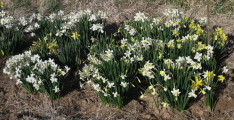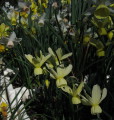There is no clear answer as to which hybrids best exemplify the characteristics of triandrus in standard sized daffodils. There seems to be a move away from hybrids with main division flowers (such as Ice Wings) to hybrids between triandrus and the fertile main division/jonquil hybrids (Hillstar x triandrus etc). It is easier to get more florets on these latter hybrids, they are more like triandrus itself, and I expect they are easier to grow. Unfortunately, these hybrids are all sterile, the Hillstar types highly so.
In shows where miniatures can compete against large flowers for champion div.5 typically a miniature will win – almost invariably a fernandesii triandrus hybrid. I understand a judge has commented – why breed them when the species is so good? And this is a good question because triandrus species would probably be preferred to its miniature hybrids. Unfortunately it is not so easy to grow.
The reason for crossing triandrus with main division daffodils is, of course, to obtain the colors and other highly bred characteristics from those flowers. All the triandrus characteristics are already present in main division flowers – cup shape, reflex, nodding poise and even multi-headed flowers (just) and, with a hundred or so years to spare, one could conceivably breed triandrus hybrids that have no triandrus ancestry. In the mean time, these sorts of flowers seem like good plants to cross with triandrus (rather than the best current exhibition flowers whose hybrids are often gross). But if we do this we face the problem of sterile triploids (given that most main division flowers are tetraploids).
Years ago an attempt was made to artificially produce tetraploid triandrus. This may have succeeded but all crosses with it failed and it has since been lost. What seemed like a high-road to fertile hybrids led nowhere.
I wrote in the March ADS Journal “The problem of reliably producing fertile hybrids in divisions 5 and 7 is possibly solved.” The reason for this is that across a number of sections there seems to be evidence that sterile triploids of the form XXY (2 sets of chromosomes from section X and 1 set from section Y) can contribute XY chromosomes to their children (rather than just X or XXY). Theo Sanders’ observations on this are important I think. In this way, Mission Bells (NNRR?) can be interpreted as Silver Bells (NNR) selfed.
Sprouting pollen in 10% sugar solution shows that many sterile triandrus hybrids (2 parts main division and 1 part triandrus – NNR) have demonstrably significant pollen fertility and so it looks an easy matter to obtain seed. This season past these ideas have been put to the test, and because triandrus hybrids tend to produce withered seed pods very quickly if no seed is being set, an early report is possible.
The sterile triandrus hybrids were moved in the winter just prior to sprouting above ground, the idea being that they will be well settled before summer. Some of these clumps consisted of several levels of bulbs stacked on top of each other. The photo is from last year.
The crossing of sterile triploids with each other and themselves has been a comprehensive, probably a complete, failure.
Yesterday I excitedly collected 1 seed from a sterile triploid crossed with my own fertile hybrid. This fertile hybrid (04/1RM) refuses to set seed but does yield fertile hybrids when crossed with Mission Bells.
It appears that Mission Bells is setting seed to a Scarlet Chord x triandrus hybrid (12/10RM) and to a Pink China x triandrus hybrid. In the picture 04/1RM is in the shadows mid-right and the Pink China hybrid top left. The 5W-Y below it, Nala x triandrus, is the one that set seed. (The subject of the photo is 11/1R, a partially fertile 04/1RM x triandrus hybrid).
The triandrus hybrids in the field have never set open pollinated seed and so my preliminary inferences are:
Crossing triploids with each other does not have favorable probability (Silver Bells is a rare plant!) and it is better for one of the parents to be fully fertile.
A key to this kind of breeding is finding a seed parent, which makes Mission Bells a very significant plant. It may be the case that it is the later florets are more likely to set seed – perhaps sheltered conditions are more favorable. An invariably sterile tazetta hybrid is also producing seed from last florets here – I’m sure Bill Welch has made remarks about this in the past.
Meanwhile, seedlings from my fertile intersectional bulbocodium hybrid crossed with 04/1RM are showing demonstrable fertility. Fertile colored triandrus hybrids via the bulbocodiums is an odd thought.
So in conclusion, it does seem that seeds can be reliably obtained, but a flood of fertile triandrus hybrids should not be expected soon, and good fertile triandrus hybrids will presumably take even longer.




Hi Lawrence,
I can add a little bit to the fertile triandrus puzzle. ‘Ice Chimes’ 5W-Y a Mitsch/Havens Registration is a cross of ‘Silver Bells’ x N. triandrus subsp. triandrus var. concolor. I can confirm that it is fertile. The late Dr. Frank Galyon sent me a seedling of ‘Ice Chimes’ x ‘Hillstar’ (FG99-20) which is an increaser similar to ‘Silver Bells’. Some of the progeny increased so fast that they would be thought to have gone “horses teeth”. Incredible vigor. FG99-20 has large yellow triandrus like flowers. It is on the list for a careful photo next spring. Will post a photo then. I have backcrossed FG99-20 using its pollen with both parents and have gotten some seed. We’ll see what happens when they bloom. Thanks for your great post!
Steve